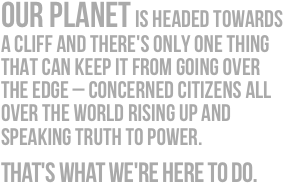-by Sarah
In a side event about deforestatrion this morning, researchers from the Woods Hole Research Institute talked about the science of emissions from tropical deforestation. I was disappointed that they did not go into specifics of monitoring procedures and how they got their numbers, but the message was clear: deforestation is a major source of greenhouse gas emissions (mostly carbon dioxide, but also methane and black soot) and that it needs to be addressed in the Kyoto Protocol. The scientists highlighted Brazil’s proposal to include prevention of deforestation in the market for CERs (Certified Emissions Reduction credits). How to measure how much carbon is actually not realeased through preventing deforestation? That’s the problem.
The panelists stressed the positive feedbacks that deforestation causes in emissions: Deforestation releases CO2, which causes climate change, which causes moist tropical forests to dry out and burn more easily, which causes deforestation. According to the presentation, 70% of Brazil’s total emissions are a result of deforestation. Emissions could double in dry years, said Dan Nepstad, senior scientist at Woods Hole. “We’ve got to harness globalization,”he said, pointing out that as space runs out for agricultural expansion to meet a growing food demand (especially soy and meat, he said), South American, followed by Africa. will be the next continents to be used for agricultural production. Globalization, and the global market, have major effects on land use- for example, because the EU has banned GMO soy, they get their soy from Brazil rather than the US. Incresed demand for agricultural products means clearing more land. Nepstad highlighted the positive progress the Brazilian government has made in increasing protected forest areas, improving enforcement of environmental law, and working with communities to sustainably manage forests (he gave the example of a program in which small communities make furniture from sustainably harvested wood and then sell it to Europe). Nepstad also credited this to the growth of Brazil’s economy.
However, in this presentation, many questions were left unanswered (perhaps it is impossible to answer them). For example. the furniture that gets shipped to Europe still seems to feed the capitalist system which seems to have society stuck in a place that, it is generally agreed upon, is not really great for our well-being and survival (not the least of which because it contributes to the kind of climate change that might make us go extinct). Also, I am not sure what it means to “harness globalization;” it seems to imply a market-based approach to things. And what about some more science of deforestation- monitoring, feedbacks, causes? I guess it all comes back to the fact that the study of climate is a relatively new thing, and will be ongoing.
On two interesting asides, John P. Holdren, director of Woods Hole and one of the presenters, pulled up the statistic that in 2004, the emissions in the US from coal-electric power were more than the emissions from motor vehicles (an important point to consider when Bush touts coal as a renewable energy, falsely labelling it “green”simply because it is abundant). Secondly, the US released a compilation of articles refuting the gloabl warming theory, in which was included an article by Bjorn Lomborg, head of the Copenhagen Consensus and a much-disliked Dane among environmentalists. The article may have been over-the-top (but, as I’ve learned, everything is spin and a matter of interpretation), but it made an interesting point to consider: perhaps one of the reasons we see environmental factors, such as extreme weather events, as causing more destruction than ever is because we have so much more to destroy- more people, more goods.


